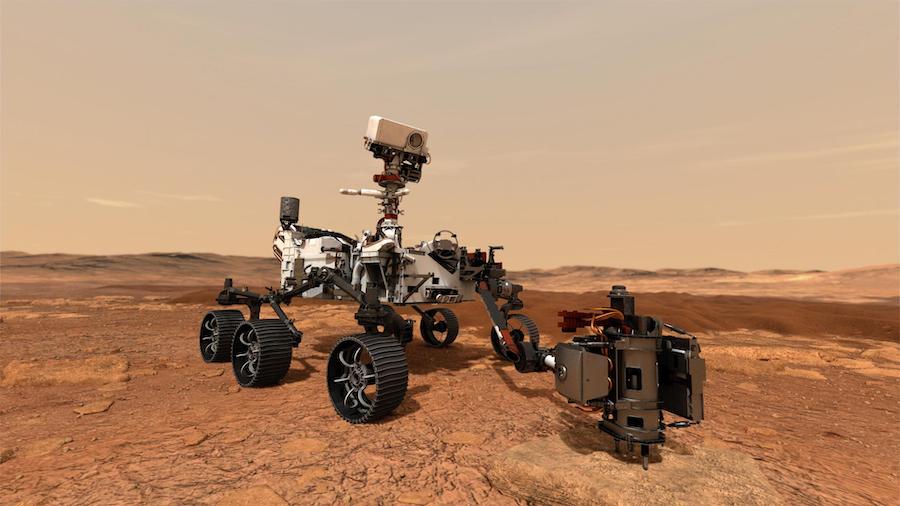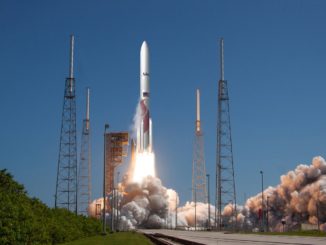
Two U.S. Air Force cargo planes delivered the Mars 2020 rover, cruise stage, descent module and the Mars Helicopter to the Kennedy Space Center in Florida this week for final assembly, fueling and mounting atop a United Launch Alliance Atlas 5 rocket in preparation for liftoff in July.
The military transport aircraft landed Wednesday at the Shuttle Landing Facility at the Kennedy Space Center with hardware for the $2.6 billion Mars 2020 mission, which was delivered to NASA’s Payload Hazardous Servicing Facility at the Florida spaceport for unpacking and launch preparations.
The Mars 2020 rover, cruise stage, descent package and helicopter departed NASA’s Jet Propulsion Laboratory in Pasadena, California, on Feb. 11 and was trucked to March Air Reserve Base in Riverside, California, and loaded into two C-17 cargo planes.
The rover and other flight hardware components were stored inside climate-controlled containers during the 2,300-mile (3,700-kilometer) cross-country trip.
Engineers and technicians built the rover and its support hardware inside a high bay at JPL over the last two years, culminating a development program that began with the Mars 2020 mission’s announcement in 2012.
“Our rover has left the only home it has ever known,” said John McNamee, NASA’s Mars 2020 project manager, in a statement. “The 2020 family here at JPL is a little sad to see it go, but we’re even more proud knowing that the next time our rover takes to the skies, it will be headed to Mars.”
Inside the PHSF clean room at the Kennedy Space Center, ground teams will test mission hardware to ensure all systems remain healthy after the cross-country flight from California to Florida.

Technicians will load hydrazine to feed maneuvering thrusters on the cruise stage, which will fine-tune the rover’s trajectory toward Mars after liftoff from Cape Canaveral on top of an Atlas 5 rocket. The Mars 2020 descent stage will also be filled with hydrazine to power braking rockets that will slow the rover before it is lowered from a “sky crane” mechanism onto the Martian surface.
The six-wheeled rover will be mated with the descent stage and the cruise stage, and enclosed inside an aerodynamic shell and heat shield by late June. The Mars 2020 aeroshell, made by Lockheed Martin, was delivered to the Kennedy Space Center in a separate shipment in December.
Then the entire vehicle will be encapsulated inside the 5.4-meter (17.7-foot) diameter payload fairing of ULA’s Atlas 5 launcher and transported to the Vertical Integration Facility near pad 41. Cranes will hoist the payload atop the Atlas 5 inside the vertical hangar.
One of the final pre-launch tasks before the Atlas 5 rolls out to the launch pad will be the installation of the rover’s nuclear battery.
The launch window for the Mars 2020 mission opens July 17 and closes Aug. 5, when Earth and Mars are in the proper positions in the solar system to enable a direct interplanetary journey. The launch time on July 17 would be targeted for approximately 9 a.m. EDT (1400 GMT), according to NASA officials.
The Mars 2020 rover will get an official name before its July launch.
NASA invited U.S. students last year to submit essays with their ideas for a name for the rover. The space agency revealed candidates for the mission name last month, and officials will announce the final name selection in March.

The Mars 2020 rover is similar in appearance to NASA’s Curiosity rover, which has explored Mars since August 2012, but the Mars 2020 rover carries an upgraded suite of scientific instruments, plus mechanisms to collect, seal and store samples of powder drilled and cored from Martian rocks.
The rock specimens will be picked up by a future robotic mission to return the samples to Earth for detailed analysis. Scientists hope to find evidence of ancient life.
The Mars 2020 rover also carries a miniature flying helicopter drone, which will deploy after landing to become the first aircraft to fly in the atmosphere of another planet. It also features aluminum wheels with thicker skin and modified treads to avoid damage observed on Curiosity’s wheels on Mars.
The rover will land on Mars on Feb. 18, 2021, targeting touchdown inside Jezero Crater, the home of a dried-up ancient river delta where evidence of ancient microbial life may be preserved from billions of years ago.
Email the author.
Follow Stephen Clark on Twitter: @StephenClark1.



